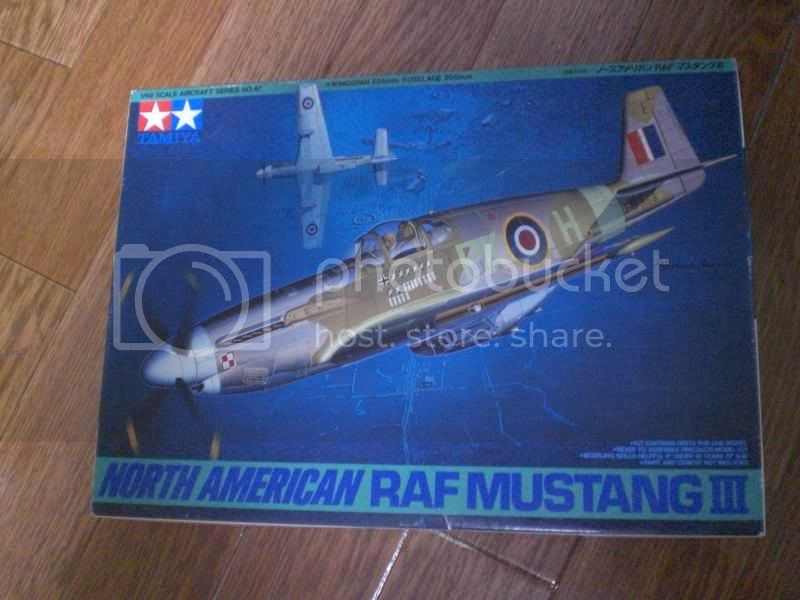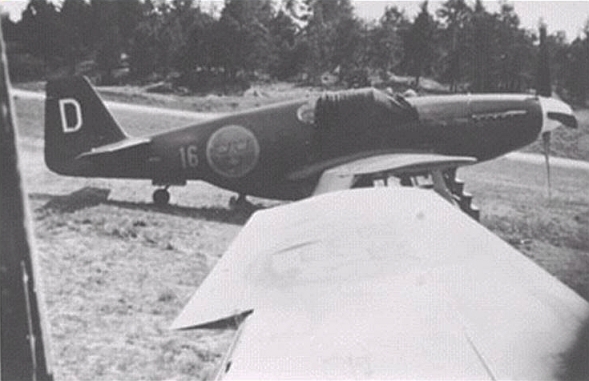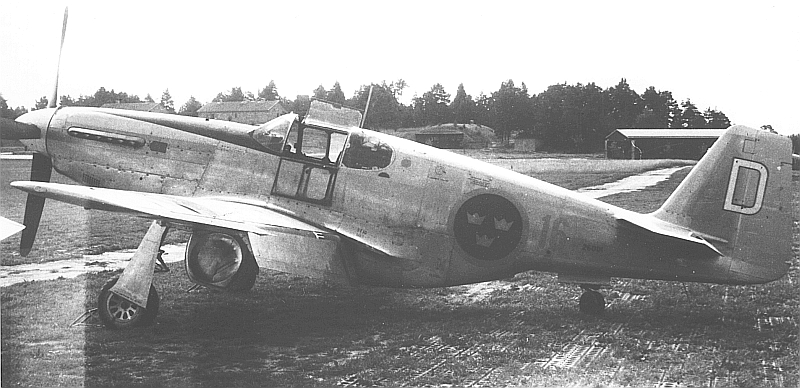A batch of Mustang Is was sent to the Soviet Union by Britain from the RAF inventory. Several sources give the number as ten whilst others put the number as four stating the serials as AG348, AG352, AG353 and AG354. The first two were forwarded for shipment to the USSR on the 16th December 1941, the last from this batch arrived on the 14th May 1942. Some sources identify them as Mustang Mk Ia but the Mustang tested at NII VVS had the armament of a Mk I and is identified as such in documents. In the USSR the Mustang was frequently referred to as the NA-73, especially in technical studies prepared by TsAGI.
AG348 was transferred to NII VSS for testing which was carried out by test pilot Vladimir Ye. Golofastov in October 1942. The unfavourable comparison with other fighter types, both Soviet and foreign, used by the Soviet Air Force prompted the Air Force command to use the Mustangs mainly at pilot training centres such as the 6th ZAB at Ivanovo. In the summer of 1942 five Mustangs were used for training the pilots of the 1st Ferry Air Division.
After testing by NII VVS three Mustangs were evaluated in combat in the 3rd Air Army on the Kalinin front in the autumn of 1942. Two were assigned to the 5th GvIAP of that Air Army and flown by the regiment's CO V. A. Zaitsev and V. I. Popkov as well as pilot Onufriyenko. The fighter was disliked by the pilots for its sluggishness. No operational sorties were flown during the evaluation which did not last very long as the Mustangs had to be withdrawn after suffering damage to their propellers.
One Mustang formed part of the exhibition of Soviet, Allied and captured German aircraft which had been set up at TsAGI's BNT. One other Mustang was transferred to the training regiment of the VVIA and flown there until at least 1946, after which it served as an instructional airframe. Neither of the two aircraft survive.
As the war progressed Soviet engineers and pilots had a chance to become acquainted with the later types of Mustang. Several Mustangs that suffered damage during operation Frantic, the shuttle bombing raids by USAAF bombers with a refuelling stop at Poltava in the Ukraine, in the summer of 1944, were left behind. They were restored to flying condition by Russian technical personnel as were several Mustangs that had force landed in Eastern Europe and salvaged by advancing Soviet troops. Fourteen Mustangs of various type were located by May 1945. Later several P-51Ds were restored to flying condition and ferried to Kratovo near Moscow where LII had its premises at the time and were subjected to a limited amount of flight testing.
=====================================================================
After the Air Ministry had approved the installation of a Merlin engine five Mustang Mk Is (AM121, AL963, AL975, AM203, and AM208) were flown to Hucknall for conversion to Mustang Xs. The first machine AL975/G flew on 13th October 1942 piloted by RR's chief test pilot Capt R T 'Ronnie' Shepherd. This had a gross weight of 9,065lb with a Merlin 65 driving a four-bladed propeller. The was a noticeable difference in profile of The Mustang Xs as small, beard radiator ducts of varying shape were fitted in addition to the standard ventral duct. On its initial flight AL975/G reached a speed of 376 mph.
Despite the initial suggestion to install a Merlin 61, all five Mustang Xs were fitted with Merlin 65s. When the second conversion, AM208, flew on 13th November 1942, its main radiator front flap was fixed permanently and sealed, as was it was on the remaining Mk Xs next converted. Considered as the prototype Mk X, AL975/G was designed to accept the Merlin 61 with its SU carburettor and resulting bulged lower cowling, but in the event , the Merlin 65 which did not have the SU type fitted , was installed. Of the other three machines, AM203 flew for the first time as a Mk X on 13th December, piloted by Ronnie Shepherd, and tested a high-speed gloss finish to compare the results against a standard matt finish. There was no variation in performance and it was concluded that the Mustang's smoothness and aerodynamic cleanness could not be improved upon.
Mk X AL963 flew into Hucknall on 26th June 1942 for performance ad handling trials before conversion from Allison to Merlin 65. it went to ADFU on service trials, returned to Hucknall, had a dorsal fin fitted, returned to Duxford for short period and then returned to Hucknall on a permanent basis where it spent most of its time on SU fuel injection pump trials.
The fifth Mk X, AM121, despite being first at Hucknall for conversion, was the last to undergo modification. Instead it was decided to retain the original configuration and study drag problems with the cooling system. Eventually this aircraft was fitted with a Merlin 65, but with no actual development flying planned, it too went to ADFU for service trials. It was then loaned to the USAAF 8th Fighter Command at Bovington, returned to Hucknall to have a broad chord fin incorporated and then flew to Rotol at Staverton, Glos, for it to evaluate a Rotoloid coating for propeller blades. After returning to Hucknall, AM121 was sent to spend the rest of its career with the USAAF 8th Fighter command Air Technical Section at Bovington.






























